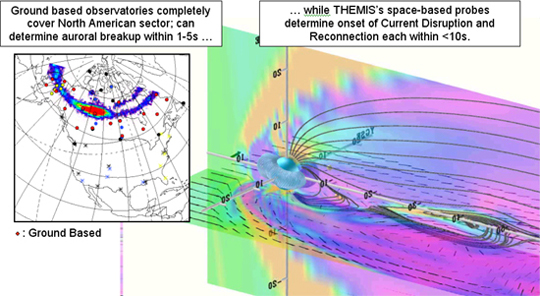
|
About THEMIS THEMIS answers fundamental outstanding questions regarding the magnetospheric substorm instability, a dominant mechanism of transport and explosive release of solar wind energy within Geospace. THEMIS will elucidate which magnetotail process is responsible for substorm onset at the region where substorm auroras map (~10Re): (i) a local disruption of the plasma sheet current or (ii) that current's interaction with the rapid influx of plasma emanating from lobe flux annihilation at ~25Re. Correlative observations from long-baseline (2-25 Re) probe conjunctions, will delineate the causal relationship and macroscale interaction between the substorm components. THEMIS's five identical probes measure particles and fields on orbits which optimize tail-aligned conjunctions over North America. Ground observatories time auroral breakup onset. Three inner probes at ~10Re monitor current disruption onset, while two outer probes, at 20 and 30Re respectively, remotely monitor plasma acceleration due to lobe flux dissipation. In addition to addressing its primary objective, THEMIS answers critical questions in radiation belt physics and solar wind - magnetosphere energy coupling. THEMIS's probes use flight-proven instruments and subsystems, yet demonstrate spacecraft design strategies ideal for Constellation class missions. THEMIS is complementary to MMS and a science and a technology pathfinder for future STP missions. THEMIS will be launched October, 2006.
|
||||||||||||||||||

CONTACTS | INTERNAL INFO | EDUCATION AND OUTREACH | ©2005 UC REGENTS



